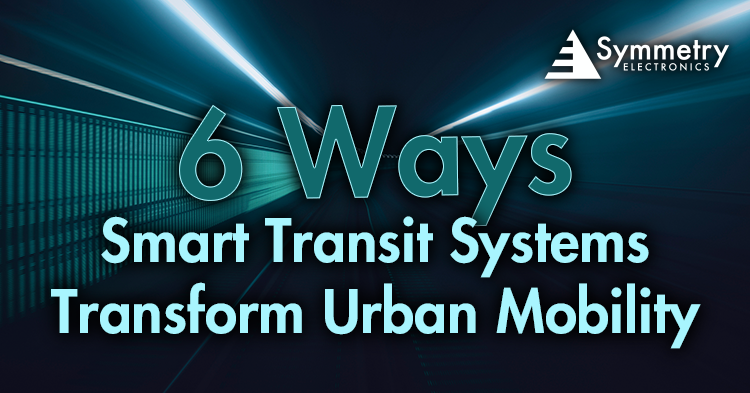- Home
- Symmetry Blog
- 6 Ways Smart Transit Systems Transform Urban Mobility
6 Ways Smart Transit Systems Transform Urban Mobility
About Jari Haiston

In the age of rapid urbanization and increasing congestion, the development of smart transit systems is ushering in a new era of urban mobility. Driven by cutting-edge technologies and engineering innovations, smart transit systems represent a groundbreaking evolution in urban transportation.
What is a Smart Transit System?
At their core, smart transit systems integrate a fusion of digital intelligence, data analytics, and advanced infrastructure to enhance the efficiency, reliability, and sustainability of public transportation in densely populated urban areas.
In practical terms, smart transit systems encompass a wide range of components and solutions. They include digitally connected vehicles, such as buses and trains, equipped with sensors and communication systems that transmit data on their location, condition, and passenger load. Smart transit systems also leverage real-time data from various sources, including sensors, GPS devices, and user inputs, to optimize transit operations, reduce congestion, and improve the overall passenger experience.
Additionally, smart transit systems often feature centralized control centers where operators can monitor and manage the entire transportation network in real-time. This allows for dynamic adjustments to routes, schedules, and traffic signals to respond to changing conditions, ensuring a more responsive and efficient transit service. Ultimately, the goal of smart transit systems is to provide seamless, sustainable, and accessible urban mobility solutions that can meet the evolving needs of modern cities.
3 Major Cities with Existing Smart Transit Systems
The age of smart technology is now. There are already major cities that have implemented and are seeing the benefits of smart transit technology. For example, Singapore has a data-rich intelligent transportation system that delivers real-time traffic alerts to the public and uses connected vehicles to improve urban mobility. New York City also has an exceptional public transportation system that uses sensor and data analytics to optimize traffic flow and reduce emissions. Additionally, Denver has a comprehensive plan that puts pedestrians first and prioritizes multimodal transportation options to enhance safety on roads and transit networks.


Top 6 Benefits of Smart Transportation
Globe Newswire estimates that the smart transportation market will reach $274.1 billion by 2032. Moreover, the European sector dominates much of the smart transportation market with 33.8% of the total market share. The rapid adoption rate of smart transportation technology can be directly attributed to the overall benefits it provides cities and their inhabitants. Here are the top 6 benefits of smart transportation integration.
1. Real-Time Data Analytics
Smart transit systems leverage advanced data analytics to provide real-time insights into traffic patterns, passenger demand, and system performance. Engineers are using this data to optimize routes, reduce congestion, and improve overall transit efficiency. By analyzing passenger flow, traffic congestion, and other relevant data points, cities can make informed decisions to enhance the quality of their transit services.
2. Predictive Maintenance
Engineers are now implementing predictive maintenance techniques using sensor data and machine learning algorithms. These systems can identify potential issues before they lead to service disruptions, minimizing downtime and ensuring a smoother transit experience. By proactively addressing maintenance needs, smart transit systems are increasing the reliability of urban transportation.
3. Enhanced Safety Features
Safety is a paramount concern in urban transportation. Smart transit systems incorporate advanced safety features such as collision avoidance systems, pedestrian detection, and automated emergency braking. These engineering innovations are reducing accidents and enhancing passenger safety.
4. Sustainable Mobility Solutions
Smart transit systems are paving the way for more sustainable urban mobility. Engineers are integrating electric and hybrid vehicles into transit fleets, reducing greenhouse gas emissions and improving air quality in cities. Additionally, smart transit systems are often designed to facilitate seamless connections with other sustainable transportation modes such as cycling and walking.
5. Mobility as a Service (MaaS)
The concept of Mobility as a Service (MaaS) is becoming a reality thanks to smart transit systems. Engineers are developing integrated platforms that allow passengers to plan and pay for their entire journey through a single app. This seamless approach to mobility encourages the use of public transit and reduces reliance on private vehicles.
6. Accessibility and Inclusivity
Smart transit systems are prioritizing accessibility and inclusivity for all passengers. Engineers are designing vehicles and infrastructure that cater to individuals with diverse mobility needs. From low-floor buses to tactile wayfinding systems, these innovations are making public transit more accessible to everyone in the community.
The Future of Urban Transportation
In conclusion, smart transit systems are engineering a transformative shift in urban mobility. By harnessing data analytics, predictive maintenance, safety enhancements, sustainability, MaaS, and inclusivity, these systems are not only improving the efficiency and reliability of public transportation but also contributing to a more sustainable and accessible urban environment. As engineers continue to innovate in this field, the future of urban mobility is set to become smarter, safer, and more sustainable than ever before.
Are you a developer interested in designing the industry’s next smart transit solution? Our team of knowledgeable Applications Engineers are experts in wireless, connected, and smart technologies and are available to guide you to your ideal design. Consultation is free and available throughout your design cycle. Contact Symmetry Electronics, today!

.png)
.png)
.jpg)